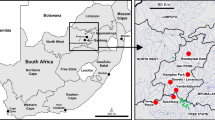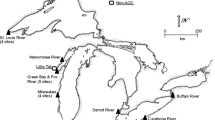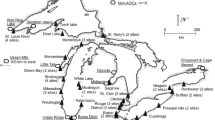Abstract
Tree swallows (Tachycineta bicolor) are widely used as indicators of local polychlorinated biphenyl (PCB) contamination in North America. Although determining total PCB residues in tissues is useful in environmental monitoring, analysis of PCB congener profiles may reveal sources of contamination and thus prove to be a more refined tool to track contaminants through the food web. To show how differences in PCB congener patterns in birds can be linked to the PCB patterns in their prey, we evaluated PCB congeners in tissues of tree swallow nestlings and their insect prey using principal component analysis and Euclidean similarities. The PC1 scores for PCB residues in nestlings fell between those of the Hexagenia (Ephemeroptera, mayflies) and Chironomidae (Diptera, midges), the two major prey groups of the nestlings. The congener pattern was not related to the location of nest boxes within the study area. However, Hexagenia insects and the nestlings that consumed them were richer in less chlorinated congeners and had higher PC1 scores than Chironomidae insect. In concordance, congener pattern of nestlings that hatched earlier and consumed more mayflies was more similar than that of other nestling to the pattern of nestings texagenia as calculated by Euclidean similarities. We point to the importance of understanding the seasonal availability of specific types of insect prey and their PCB congener pattern before these data are applied in models of trophic transfer of individual PCB congeners within a food web.




Similar content being viewed by others
References
Ankley GT, Niemi GJ, Lodge KB, Harris HJ, Beaver DL, Tillitt DE, et al. (1993) Uptake of planar polychlorinated-biphenyls and 2,3.7,8-substituted polychlorinated dibenzofurans and dibenzo-p-dioxins by birds nesting in the lower fox river and green bay, Wisconsin, USA. Arch Environ Contam Toxicol 24:332–344
Bishop CA, Koster MD, Chek AA, Hussell DJT, Jock k (1995) Chlorinated hydrocarbons and mercury in sediments, red-winged blackbirds (Agelaius phoeniceus) and tree swallows (Tachycineta bicolor) from wetlands in the Great Lakes–St. Lawrence river basin. Environ Toxicol Chem 14:491–501
Ciborowski JJH, Corkum LD (1988) Organic contaminants in adult aquatic insects of the St. Clair and Detroit rivers, Ontario, Canada. J Great Lakes Res 14:148–156
Corkum LD, Ciborowski JJH, Lazar R (1997) The distribution and contaminant burdens of adults of the burrowing mayfly, Hexagenia, in Lake Erie. J Great Lakes Res 23:383–390
Custer TW, Custer CM, Hines RK (2002) Dioxins and congener-specific polychlorinated biphenyls in three avian species from the Wisconsin River, Wisconsin. Environ Pollut 119:323-332
Custer CM, Custer TW, Dummer PM, Munney KL (2003) Exposure and effects of chemical contaminants on tree swallows nesting along the Housatonic River, Berkshire Country, Massachusetts, ESA, 1998-2000. Environ Toxicol Chem 22:1605–1621
Custer CM, Read LB (2006) Polychlorinated biphenyl congener patterns in tree swallows (Tachycineta bicolor) nesting in the Housatonic River watershed, western Massachusetts, USA, using a novel statistical approach. Environ Pollut 142:235–245
Drouillard KG, Ciborowski JJH, Lazar R, Haffner GD (1996) Estimation of the uptake of organochlorides by the Mayfly Hexagenia limbata (Ephemeroptera: Ephemeridae). J Great Lakes Res 22:26–35
Drouillard KG, Fernie KJ, Smits JE, Bortolotti GR, Birds DM, Norstrom RJ (2001) Bioaccumulation and toxicokinetics of 42 polychlorinated biphenyl congeners in American kestrels (Falco sparverius). Environ Toxicol Chem 20:2514–2522
Echols KR, Tillitt DE, Nichols JW, Secord AL, McCarty JP (2004) Accumulation of PCB congeners in nestling tree swallows (Tachycineta bicolor) on the Hudson River, New York. Environ Sci Technol 38:6240–6246
Froese KL, Verbrugge DA, Ankley GT, Niemi GJ, Larsen CP, Giesy JP (1998) Bioaccumulation of polychlorinated biphenyls from sediments to aquatic insects and tree swallow eggs and nestlings in Saginaw Bay, Michigan, USA. Environ Toxicol Chem 17:484–492
Gewurtz SB, Diamond ML (2003) Distribution and burdens of bioaccumulative contaminants in the Lake Erie food web: A review. Environ Rev 11:141–160
Gobas FAPC, Bedard DC, Ciborowski JJH, Haffner GD (1989) Bioaccumulation of chlorinated hydrocarbons by the mayfly (Hexagenia limbata) in lake St. Clair. J Great Lakes Res 15:581–588
Harris ML, Elliott JE (2000) Reproductive success and chlorinated hydrocarbon contamination in tree swallows (Tachycineta bicolour) nesting along rivers receiving pulp and paper mill effluent discharges. Environ Pollution 110:307–320
Hawker DW, Connell DW (1988) Octanol-water partition coefficients of polychlorinated, biphenyl congeners. Environ Sci Technol 22:382–387
Heidtke T, Hartig JH, Zarull MA, Yu B (2006) PCB levels and trends within the Detroit River–Western Lake Erie basin: A historical perspective of ecosystem monitoring. Environ Monit Assess 112:23–33
Kay DP, Blankenship AL, Coady KK, Neigh AM, Zwiernik MJ, Millsap SD, et al. (2005) Differential accumulation of polychlorinated biphenyl congeners in the aquatic food web at the Kalamazoo river superfund site, Michigan. Environ Sci Technol 39:5964–5974
Kelly TJ, Czuczwa JM, Sticksel PR, Sverdup GM, Koval PJ, Hodanbosi RF (1991) Atmospheric and tributary inputs of toxic substances to Lake Erie. J Great Lakes Res 17:504–516
Kovats ZE, Ciborowski JH (1989) Aquatic insect adults as indicators of organochlorine contamination. J Great Lakes Res 15:623–634
Mackay D, Shiu WY, Billington J, Huang GL (1983) Physical chemical properties of polychlorinated biphenyls. In Mackay D, Pattersom S, Eisenreich SJ, Simmons MS, (eds) Physical behavior of PCBs in the Great Lakes. Ann Arbor Science, Ann Arbor, MI pp 59–70
Marvin CH, Painter S, Charlton MN, Fox ME, Thiessen PAL (2004) Trends in spatial and temporal levels of persistent organic pollutants in Lake Erie sediments. Chemosphere 54:33–40
Maul JD, Belden JB, Schwab BA, Whiles MR, Spears B, Faris JL, et al. (2006) Bioaccumulation and trophic transfer of polychlorinated biphenyls by aquatic and terrestrial insects to tree swallows (Tachycineta bicolor). Environ Toxicol Chem 25:1017–1025
McCarty JP (2001) Use of tree swallows in studies of environmental stress. Rev Toxicol 4:61–104
Menglekoch JM, Niemi GJ, Regal RR (2004) Diet of the nestling tree swallow. Condor 106:423–429
Nichols JW, Echols KR, Tillitt DE, Secord AL, McCarty JP (2004) Bioenergetics-based modeling of individual PCB congeners in nestling tree swallows from two contaminated sites on the upper Hudson River, New York. Environ Sci Technol 38:6234–6239
Novak MA, Reilly AA, Bush B, Shane L (1990) In situ determination of PCB congener-specific first order absorption/desorption rate constants using Chironomus tentans larvae (Insecta: Diptera: Chironomidae). Water Res 24:32l–327
Papp Z, Bortolotti GR, Smits JE (2005) Organochlorine contamination and physiological responses in nestling tree swallows in Point Pelee National Park, Canada. Arch Environ Contam Toxicol 49:563–568
Secord AL, McCarty JP, Echols KR, Meadows JC, Gale RW, Tillitt DE (1999) Polychlorinated biphenyls and 2,3,7,8-tetrachlorodibenzo-p-dioxin equivalents in tree swallows from the upper Hudson River, New York State, USA. Environ Toxicol Chem 18:2519–2525
Smits JEG, Wayland ME, Miller MJ, Liber K, Trudeau S (2000) Reproductive, immune, and physiological end points in tree swallows on reclaimed oil sands mine sites. Environ Toxicol Chem 19:2951–2960
Smits JEG, Bortolotti GR, Sebastian M, Ciborowski JJ (2005) Spatial, temporal, and dietary determinants of organic contaminants in nestling tree swallows in Point Pelee National Park, Ontario, Canada. Environ Toxicol Chem 12:3159–3165
Wayland M, Trudeau S, Marchant T, Parker D, Hobson KA (1998) The effect of pulp and paper mill effluent on an insectivorous bird, the tree swallow. Ecotoxicology 7:237–251
Acknowledgments
We thank K. G. Drouillard for GC analyses and preparations; J. J. H. Ciborowski for helpful comments on the manuscript; and A. Anaka, P. Garcia and M. Alvarez for research assistance. We would like to thank numerous people from Point Pelee National Park (Parks Canada) G. Mouland, D. Reive, T. Linke and the park wardens for their continuous support. We also thank the two anonymous reviewers of the manuscript for helpful comments. This research was funded through grants from NSERC, Suncor Energy, and Syncrude Canada Ltd (J. S., G. B., and J. J. H. Ciborowski).
Author information
Authors and Affiliations
Corresponding author
Rights and permissions
About this article
Cite this article
Papp, Z., Bortolotti, G.R., Sebastian, M. et al. PCB Congener Profiles in Nestling Tree Swallows and Their Insect Prey. Arch Environ Contam Toxicol 52, 257–263 (2007). https://doi.org/10.1007/s00244-006-0037-z
Received:
Accepted:
Published:
Issue Date:
DOI: https://doi.org/10.1007/s00244-006-0037-z




